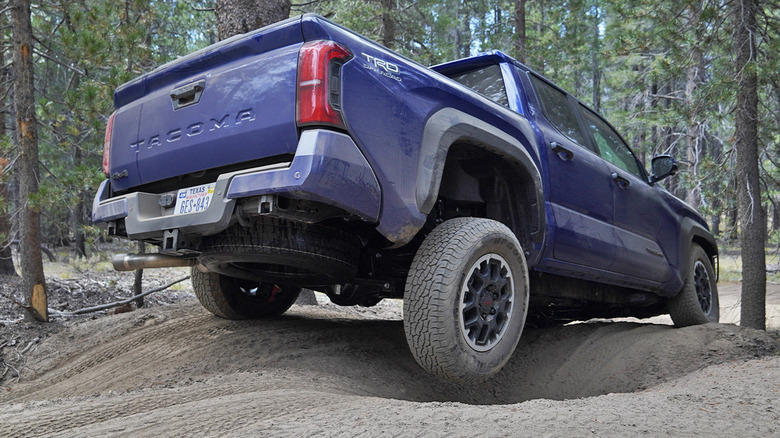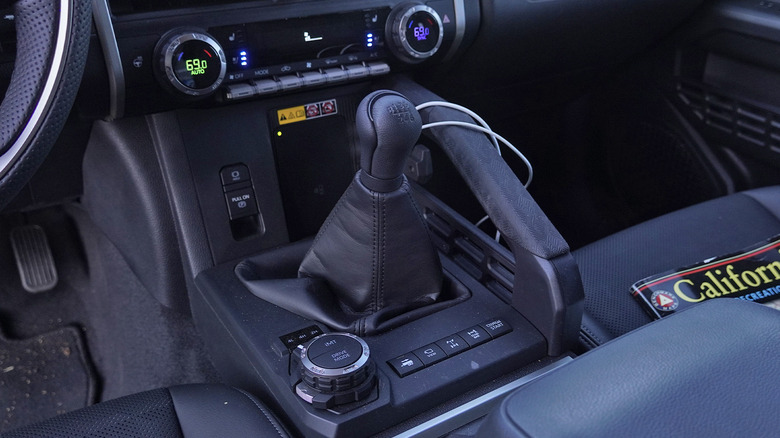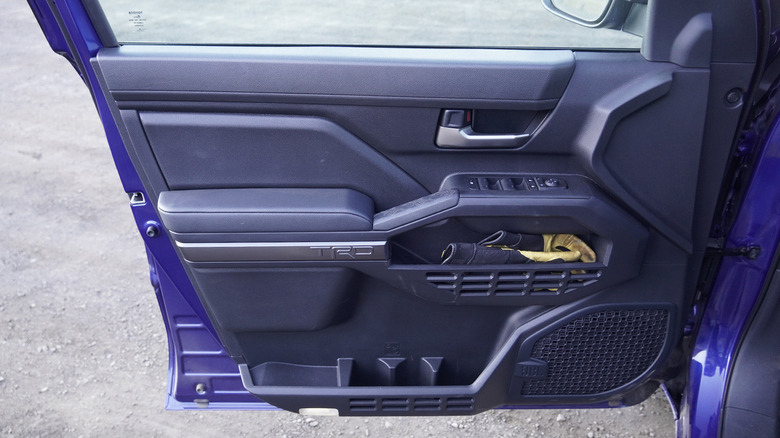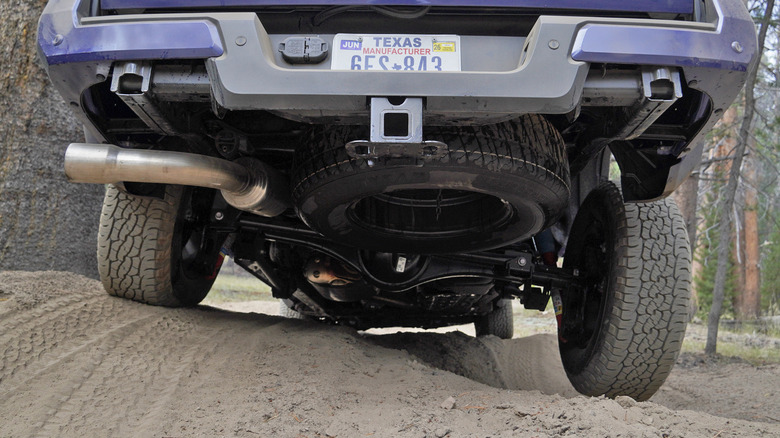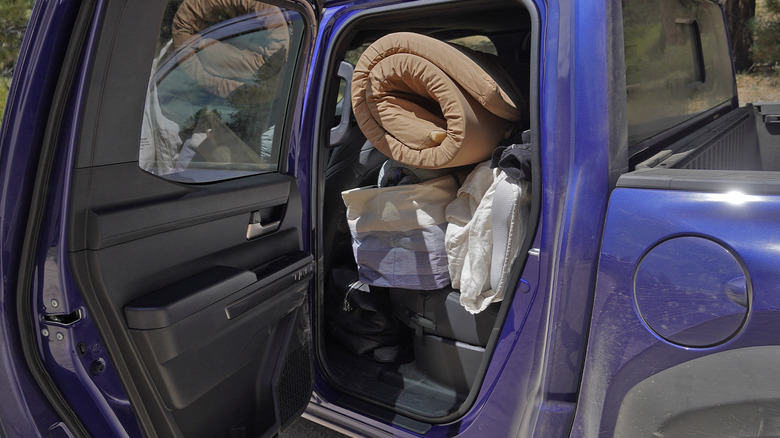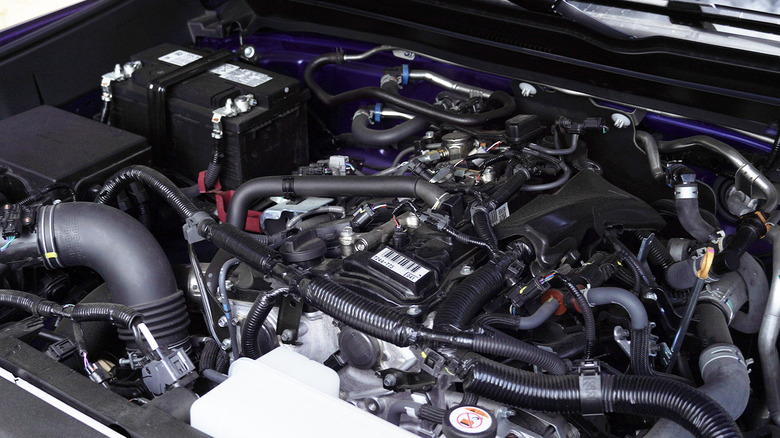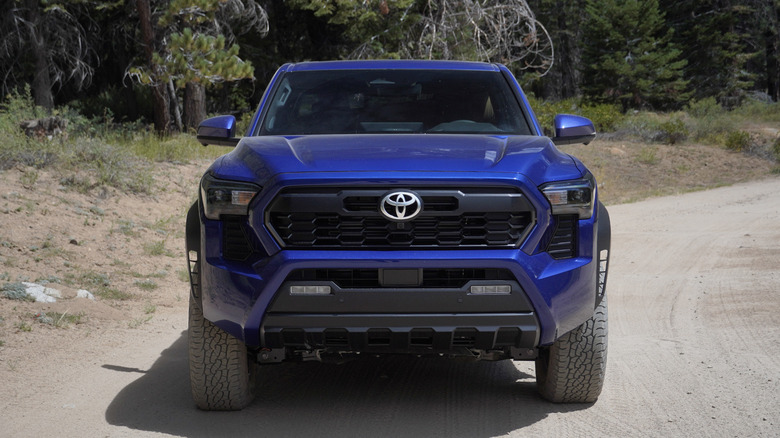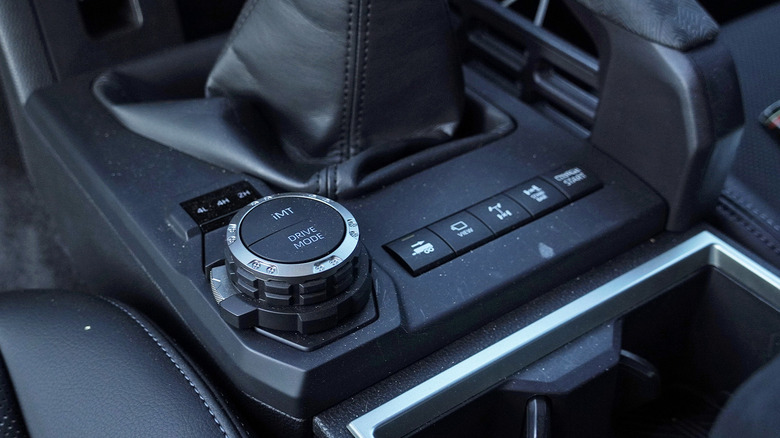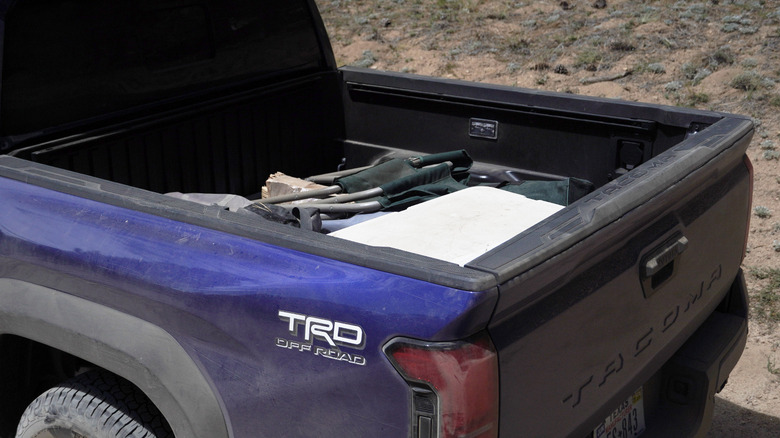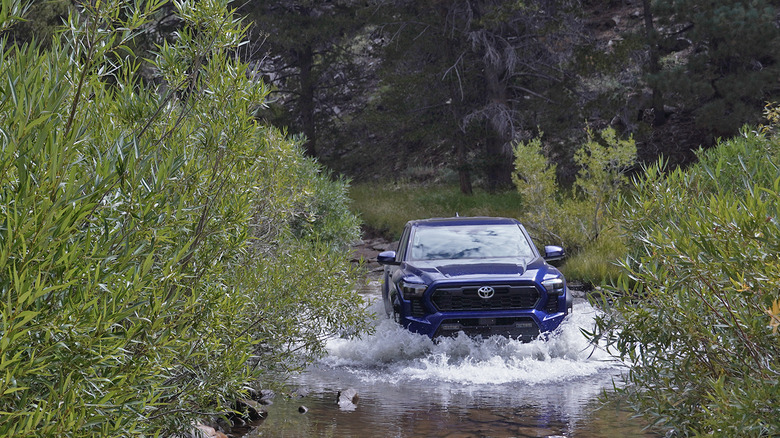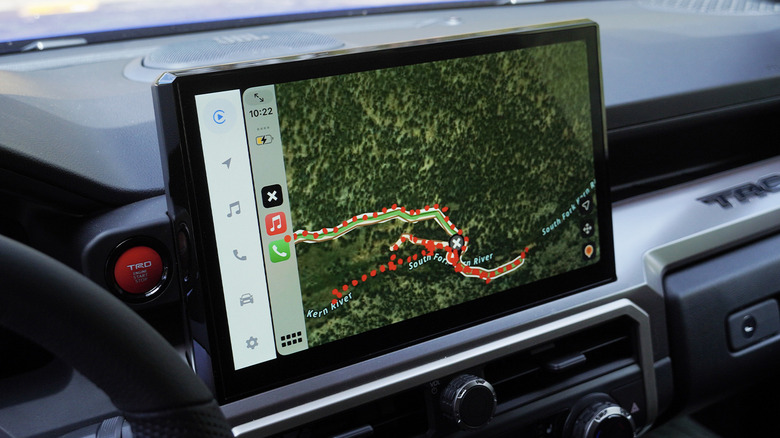2024 Toyota Tacoma Manual Review: An Unexpected Disaster
- Toyota build quality
- Updated interior ergonomics with modern tech
- At least there's a stick shift at all!
- Respectable suspension, locking rear diff, disconnecting sway bars
- Underpowered turbo-four engine
- Downright peculiar gear ratios
- Some clutch chatter when shifting quickly
- Baffling software decisions, especially for the e-brake
Almost a year and a half after Toyota officially debuted the fourth-generation Tacoma in Hawaii, I finally got a chance to experience the new truck this fall in California. Before this loan, I had only experienced the third generation's TRD Pro trim level equipped with a manual transmission, so when a new, blue TRD Off-Road pulled up outside my West LA apartment again with a stick shift, I decided a long road trip must be worth the effort.
At that Hawaii launch event, proud marketing efforts focusing on the fourth-gen's fancy bouncy seats, adjustable dampers, and five-link rear suspension design made me chuckle just a bit, since an early-1990s Mitsubishi Montero featured all of the above. But more importantly, the new Tacoma adds significant updates to attract the modern American pickup truck buyer: a big-time interior glowup, including a crispy touchscreen with wireless Apple CarPlay capabilities, plus more charge ports everywhere and more storage, all to go along with an optional hybrid engine.
What's not modern? The fact that the new Tacoma even comes in a manual at all. Awesome, I thought, since the previous gen's stick shift entirely transformed an otherwise banal, if utilitarian, pickup into a legitimately fun sports car. And with a torquey new turbocharged inline-four to replace a lethargic V6 engine, surely the fourth-gen Taco must only build on that impression.
Time to pack up and hit the road, then, for what ended up as something of a three-part review: for the new Taco in general, the TRD Off-Road package, and whether the manual makes any sense in the modern era.
First, the new Taco
Immediately, the updated interior with more tech connectivity stood out. I always pull up Waze to keep an eye out for cops, especially on long road trips when velocitation often catches me by surprise. And I wanted to take the Tacoma off-roading up the Eastern Sierra Nevada mountain range to find some colder weather, so using the OnX Offroad app to find trails and campsites on the touchscreen also helped. The whole redesign of the center console, with a wireless charging slot for my iPhone plus plenty of storage slots in the dash and doors, made the front two seats quite comfortable.
Of course, seat ventilation is my number-one favorite piece of automotive technology from the past 20 years—making the modernity of the Tacoma seeming almost complete. But carryovers from Tacos of old also helped, including the solid tactility of the physical knobs and switchgear. This gen also relocates all of the off-roading buttons to directly below my right hand, too.
But the backseat, on the other hand, presented problems. With the front seat scooted into my ideal position at six-foot-one with long legs, the backseat legroom got so cramped I—quite literally—only fit four fingers between the front seatback and rear seat's bottom cushion. Admittedly, I never pack too light for an off-roading trip, and in this case I needed to bring motorcycle gear for a quick track day stopover at Sonoma Raceway. But Toyota specifically told me in Hawaii that 40% of Tacoma buyers surveyed rarely put people in the backseat, and 15% never schlep around more than one passenger. This is little more than a dog seat, then, so why not stick with just an extra-cab layout with a longer bed?
Spoiled for choice, sort of
Toyota retained the extra cab and longer bed configuration for this new truck, but for absolutely no rational reason, only offers certain layouts with certain powertrain options and trim levels. Outside of the online configurator, the whole gradewalk easily becomes somewhat obfuscated. The stick shift only comes with the turbo-four engine, which puts out 278 horsepower and 317 lb-ft of torque. Then the turbo-four can come with the new eight-speed automatic. The hybrid engine puts out 326 horsepower and a serious 495 lb-ft, but obviously requires the automatic transmission. The TRD Off-Road can come with the manual, but not a long bed, while the TRD Pro only comes with the hybrid and a short bed. The rebooted TRD PreRunner only comes in an extra cab with long bed, but also only in two-wheel drive.
Want an extra cab with a long bed and the manual? You need to skip a rear locker or disconnecting sway bar. Want a TRD Pro without the suspension seats, which only further reduce backseat legroom? Guess again. How about a hybrid with the long bed? Actually, I'm not even sure. Just take a trip down to the Toyota dealer and see what they've got, seems to be the best option...
Part Deux: the TRD Off-Road
Such configuration website headaches then bring us right into the meat of testing the TRD Off-Road. Something I looked forward to, actually, because I wanted to experience Toyota's disconnecting sway bars for the first time—the Lexus GX I drove previously lacked the Overtrail package and at the time, I faced the prospect of trading the Taco in for a Land Cruiser the week after. But I love disconnecting sway bars on Jeep's Wrangler and Gladiator, Ford's Bronco, even the 955-generation Porsche Cayenne that came with a rare Advanced Off-Road Technology Package back in 2004 with both front and rears able to flex at the touch of a button.
The rest of the TRD Off-Road kit includes Bilstein shocks, 17-inch wheels shod in 31-inch BFGoodrich Trail-Terrain tires, and some skid plates to protect the engine, gearbox, and transfer case—but not the nice shiny skids of a TRD Pro, note, plus no matching BFG spare. And when I checked the window sticker on this TRD Off-Road, I then experienced the surprise of learning that the "Stabilizer Disconnect Mechanism" actually costs another $1,230 on top of the $8,940 for the TRD Off-Road Premium Package.
All told, this truck totals up to $53,890 including delivery and handling. Not outlandish in the modern era, but still pretty pricey for a stick-shift and turbo-four truck with a tiny backseat and a short bed. And I needed all the storage possible, hoping to keep my gear once we turned off the highway onto a dirt road.
Not quite a hardcore off-roader
But first, time to air down. I usually run at around 22 to 24 PSI while off-roading, so not too terribly low, generally for a bit more comfort than anything else. In the TRD Off-Road, that extra compliance made a big difference, though, because even with the Bilsteins, the suspension never jumped up to the level of refinement that I expected from the fourth-generation Tacoma. This era's escalating truck wars spoil buyers for choice between hardcore pickups: Chevy's Colorado ZR2 with those spectacular Multimatic dampers or the Ranger Raptor with Fox LiveValve shock absorbers. By comparison, the TRD Off-Road's passive Bilsteins just get the job done without ever truly excelling.
The sidewall flex of the Trail-Terrains helped, and on the highway portion of the trip, the BFGs never contributed to much to road hum, either. But off-road, the suspension provided just enough travel midway through the stroke to absorb most punishment, without creating that sense of float that better components manage. I never went full-gas, in fairness, figuring the TRD Off-Road setup trends more toward overlanding-style than Baja dune and whoop-blasting. But the suspension still bottomed out a few times inexplicably and hit full droop on a couple of occasions, too.
On a couple of mildly technical segments into and out of Monache Meadows, I fired up the locking rear differential just to make sure the system works. But really, I used the disconnecting sway bar — arguably an overlanding must-have — most to help prevent the cabin from pitching and rolling quite so much. Unfortunately, Toyota's system reconnects at around 17 or 18 miles per hour, the same as Jeep, whereas Ford allows for higher speeds. But at both high and low speeds, the Taco's manual gearshifter caused the most concern.
Part 3: Is the Stick Shift a Solution, or Part of the Problem?
Which brings us straight into part three of this here review, folks: whether to buy the fourth-gen Tacoma with a manual transmission, either for the purposes of daily driving, or off-roading, or both. For the former, even in town before hitting the road, I immediately noticed that the gearshift lever almost flexes, plus the gearbox itself has very odd gear ratios, making life with the stick-shift Tacoma somewhat of a chore.
First gear starts out super short, to get a quick launch off the line and spool the little turbo up quickly. The torque rating of 317 lb-ft might sound beefy, but boost only starts to come on once well over 3,000 RPM, and the engine's paltry redline sits at just over 5,000 RPM. Second gear then jumps to a much taller ratio, which meant that if I shifted normally at around 3,000 or 3,500 RPM, then second dropped me down to around 1,200 RPM—losing all turbo pressure and power, thereby causing a disconcerting forward lurch. So I either needed to rev up to well above 4,000 RPM or even near redline, and then shift to second as quickly as possible in the hopes of keeping the engine in its powerband.
The actual pressure required to push in the clutch pedal is light enough that stop-and-go traffic won't cause leg soreness. But the clutch itself tends to make bad noises. And I mean to the point where if I had bought this truck, I'd take it in for a warranty repair. Trying to upshift while feeding in any throttle at anywhere above 30 miles per hour caused the most concern, somewhere between a rattle and the metal-on-metal of gears grinding. Shifting quickly at lower speeds also caused the noise to crop up repeatedly. I started to think about double-clutching, but instead needed to essentially shift into neutral, then wait a beat before slotting into the next gear without rev matching.
Slow-speed stick-shifting off-road
At least the ratios for third and fourth gear make more sense, perhaps because Toyota needed to compensate less for turbo lag. But up at highway speeds, fifth and sixth are so close as to almost seem redundant—in sixth, I cruised at 75 MPH with the tach at 2,250 RPM.
If the manual seemed odd on-road, the situation only got weirder off-road. Even in the first mile or so out to Monache Meadows, I got sick of constantly clunking around between first and second, then only occasionally up to third, that I wound up switching the transfer case into 4-Low (which requires coming to a stop in Neutral, then pushing a button—no manual transfer case lever here, sadly).
In 4-Low, I spent more time enjoying the Taco's happy place in third and fourth gear. On slower-speed climbs and descents, I then dropped into second. Not much of this trail required the real crawler speed of first in 4-Low, but then again the TRD Off-Road isn't supposed to satisfy true rock crawlers. And yet, the suspension and gearbox also don't fit the bill for higher-speed stuff, especially given when the sway bar reconnects.
Parking brake woes
Meanwhile, the e-brake (or, more accurately, the parking brake) also became something of a bummer. And I don't just mean for drifting fun, but while off-roading and probably on steep hill starts on-road, too. I first noticed the problem when I tried to stop on a bit of an off-camber rocky ledge, with a tire up in the air, to take some dramatic pictures for this story. I put the truck in Neutral and tried to engage the e-brake for safety. But the Tacoma's computer declined, flashing a warning on the gauge cluster that read "Steep Slope / Park on Flat Road" instead.
This presents some serious concerns, and not just for my photography. In town, the truck might not allow the e-brake to engage while parked on the steep slopes of a San Francisco hill, for example. But off-road, if I got a bit stuck or into a sketchy situation, then wanted to jump out and check my line, I'd need to only leave the transmission in gear with no e-brake activated. On a steep enough slope, would the engine rotate? Similarly, the more common electric parking brake's inability to let me feather in the handbrake if I needed to stop and start at a seriously slow pace also exists.
Admirably sticking with the stick shift, at the very least
And the Tacoma's hill hold assist function works all wrong, too. After engaging the hill hold, instead of deactivating based on a wheel-speed sensor, the system lets loose the very second the clutch pedal starts to move. So instead of smoothly getting moving, without hill hold or a handbrake, I basically needed to pop the clutch in and out as quickly as possible and give enough gas not to stall (okay, I stalled once). After a dry and dusty burnout, the Taco climbed right up and over this intermediate obstacle—but not without a bit of sweat and plenty of swearing, first.
I can say without doubt that I've never seen a car, truck, or SUV that will not activate the parking brake on a steep slope. For the manual Toyota Tacoma, especially, that engineering or software decision absolutely boggles the mind. But hey, at least we've got a trailer brake controller as part of the Towing Technology Package that's nested in the TRD Off-Road Premium Package. That's a bit of a laugh because I cannot imagine the misery of actually towing anything with the turbo-manual drivetrain.
Even though I do appreciate that Toyota still offers a manual in the first place, after putting 1,200 miles on the new Tacoma, I truly believe the eight-speed auto represents a better choice for every single buyer. On road, the eight-speed will drive much smoother—off-road, the eight-speed will optimize low-end torque and help with smoother stop-start transitions. It'll arguably be safer, too, given the e-brake and hill hold situation.
Just go for the automatic, and probably the hybrid
Plus, the manual's fuel economy isn't even a huge plus. I averaged below 20 MPG for the whole trip, made up mostly of highway miles but also some city driving and those short stints in the dirt. My best tank, entirely headed south on the long, straight stretches of the 5 freeway, never cracked 22 MPG. For that reason, in hindsight after driving the new Land Cruiser equipped with the hybrid, the prospect of shelling out another $4,800 on any of the higher trim Tacomas makes much more sense.
When equipped with the manual transmission, the fourth-gen Tacoma also loses all the fun factor of the third-gen—even with the naturally aspirated V6. But I traded back the truck still hoping to one day try out a TRD Pro with the silly seats and the top-spec powertrain. Or a Trailhunter, though again, I'm not sure whether that trim can include the seats. Sigh, back to the configurator...
For an off-roader, in particular, the manual also provides no benefits with the TRD Off-Road package. And hopefully the TRD Pro and Trailhunter packages perform better, to keep up with the highly enjoyable Colorado ZR2 or Ranger Raptor.
2024 Tacoma TRD Off-Road Manual Verdict
Versus those two American pickups, the question of Toyota reliability certainly comes into play. But given recent issues with the Tundra's twin-turbo V6, or GR Corolla warranty claims, my mind balks a little at declaring the new Tacoma an outright winner here (the third-gen, for sure). At the very least, I can confirm that on-road and off, this TRD's initial build quality stood out, with absolutely zero creaks or rattles, and not even much wind noise. The incessant dinging of parking sensors even seemed to tone down versus other Toyotas and Lexuses of the past few years. Perhaps somebody, somewhere is listening?
Other little details proved that a certain level of thought went into the truck. Ventilated seats are a must-have in my mind, if I ever bought a new truck and especially in the context of off-roading or climbing back into a hot truck after a day riding sport bikes at Sonoma Raceway—yet neither the Bronco Raptor nor Ranger Raptor offer them as an option. I appreciated being able to turn off the bed lights with the tailgate down, since I brought some nifty lithium-ion batteries and lamps from Nestout to camp with in the hopes of reducing drain on the Tacoma's battery at night.
Looking back at my trip in the 2024 Tacoma, the fact that everything else seems so solidly built—in quintessential Toyota fashion—only serves to highlight the disappointing shift lever, clutch chatter, and gutless engine. For Tacoma fans who absolutely despise automatic transmissions, just stick with a third-gen. Enjoy that outdated analog experience in a relic, and leave the modern improvements to trucks equipped with modern powertrains.
